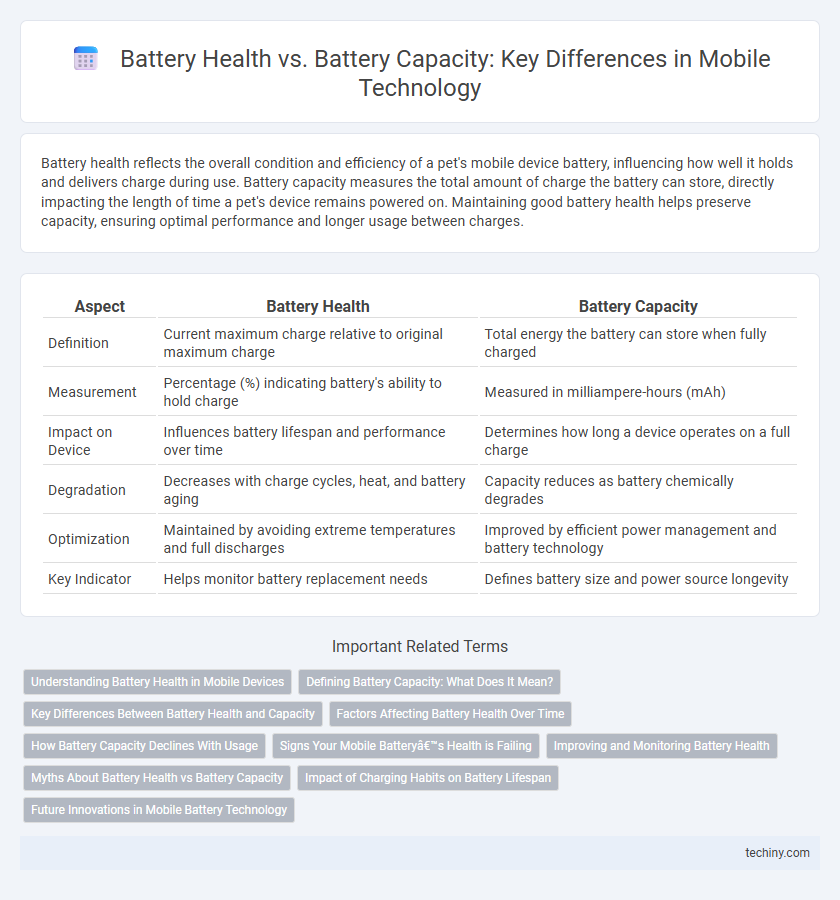Battery health reflects the overall condition and efficiency of a pet's mobile device battery, influencing how well it holds and delivers charge during use. Battery capacity measures the total amount of charge the battery can store, directly impacting the length of time a pet's device remains powered on. Maintaining good battery health helps preserve capacity, ensuring optimal performance and longer usage between charges.
Table of Comparison
| Aspect | Battery Health | Battery Capacity |
|---|---|---|
| Definition | Current maximum charge relative to original maximum charge | Total energy the battery can store when fully charged |
| Measurement | Percentage (%) indicating battery's ability to hold charge | Measured in milliampere-hours (mAh) |
| Impact on Device | Influences battery lifespan and performance over time | Determines how long a device operates on a full charge |
| Degradation | Decreases with charge cycles, heat, and battery aging | Capacity reduces as battery chemically degrades |
| Optimization | Maintained by avoiding extreme temperatures and full discharges | Improved by efficient power management and battery technology |
| Key Indicator | Helps monitor battery replacement needs | Defines battery size and power source longevity |
Understanding Battery Health in Mobile Devices
Battery health in mobile devices refers to the overall condition and efficiency of the battery, which influences how well the device can hold and deliver charge. Unlike battery capacity, which measures the maximum charge the battery can store, battery health assesses the degradation level caused by usage cycles and environmental factors. Monitoring battery health helps users maintain optimal device performance and prolong battery lifespan by identifying when capacity begins to decline significantly.
Defining Battery Capacity: What Does It Mean?
Battery capacity refers to the total amount of electric charge a mobile device's battery can store, typically measured in milliampere-hours (mAh). It determines how long a smartphone or tablet can operate on a single charge before needing to be recharged. Battery health, in contrast, indicates the current state of the battery's ability to hold charge relative to its original capacity, reflecting wear and aging over time.
Key Differences Between Battery Health and Capacity
Battery health refers to the overall condition and efficiency of a mobile device's battery in retaining charge over time, while battery capacity measures the maximum amount of charge the battery can hold at a given moment. Battery health degrades due to chemical aging and usage cycles, impacting the battery's ability to maintain its original capacity. Understanding the differences is crucial for optimizing device performance and determining when a battery replacement is necessary.
Factors Affecting Battery Health Over Time
Battery health in mobile technology reflects the battery's ability to hold charge and deliver optimal performance, which gradually declines due to chemical aging and usage patterns. Factors affecting battery health over time include temperature extremes, high charge cycles, deep discharges, and exposure to fast charging, accelerating capacity degradation. Maintaining moderate temperatures and avoiding frequent full discharges can help preserve battery health and extend overall battery capacity lifespan.
How Battery Capacity Declines With Usage
Battery capacity in mobile devices gradually declines with regular usage due to chemical aging and charge cycle exhaustion, leading to reduced maximum charge storage over time. As battery capacity decreases, users experience shorter battery life between charges, impacting overall device performance and usability. Monitoring battery health metrics helps predict capacity loss and optimize charging habits to extend the functional lifespan of mobile batteries.
Signs Your Mobile Battery’s Health is Failing
Decreased battery capacity often leads to shorter device usage and unexpected shutdowns, signaling deteriorating battery health. Noticeable signs include rapid battery percentage drops, slower charging times, and the device overheating during light tasks. Monitoring battery diagnostics and using apps to assess battery cycle counts can help identify when the battery health is declining.
Improving and Monitoring Battery Health
Improving battery health involves managing charge cycles, avoiding extreme temperatures, and using optimized charging technologies to extend overall lifespan. Monitoring battery health relies on built-in smartphone tools and third-party apps that track parameters like battery capacity, voltage, and charge cycles for accurate diagnostics. Maintaining battery health ensures sustained battery capacity and optimal device performance over time in mobile technology.
Myths About Battery Health vs Battery Capacity
Battery health and battery capacity are often misunderstood, with many users believing that maintaining 100% battery health guarantees full battery capacity, which is not always true. Battery health refers to the current maximum charge compared to the original charge capacity, while battery capacity declines naturally over time due to charge cycles and chemical aging. Myths persist that overcharging or frequent charging damage battery health, but modern mobile technology employs intelligent charging algorithms to optimize battery life and capacity.
Impact of Charging Habits on Battery Lifespan
Battery health reflects the current state of a mobile device's battery, while battery capacity indicates its maximum charge storage compared to when new. Frequent fast charging, overnight charging, and maintaining a battery level between 20% and 80% can significantly impact battery lifespan by accelerating capacity degradation. Adopting optimized charging habits preserves battery health, extending the effective lifespan and maintaining optimal battery capacity for longer periods.
Future Innovations in Mobile Battery Technology
Future innovations in mobile battery technology aim to improve both battery health and capacity through advanced materials like solid-state electrolytes and silicon anodes, which enhance energy density and cycle life. Emerging techniques such as smart battery management systems use AI to optimize charging patterns, extending overall battery longevity while maintaining optimal capacity. Research into flexible and fast-charging batteries promises to revolutionize mobile devices by delivering longer-lasting power without compromising size or user convenience.
Battery health vs Battery capacity Infographic

 techiny.com
techiny.com